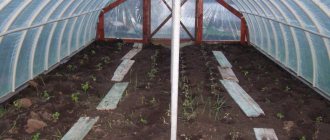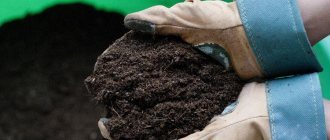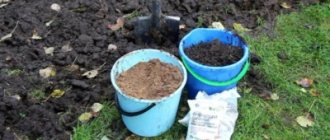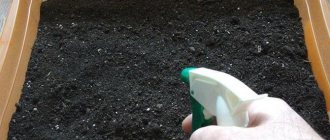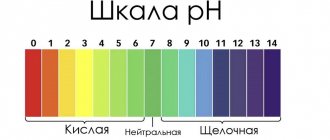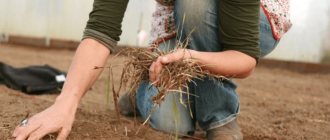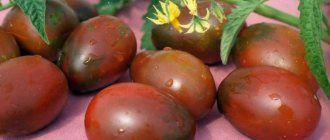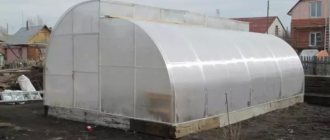Being one of the most accessible and cheapest, treating the soil with copper sulfate before planting is practiced by many gardeners on all types of soils and in any climate.
The main effect achieved from the use of copper sulfate is the inhibition of fungal spores, a negative effect on some insect pests, and repelling rodents. At the same time, copper, which predominates in the composition of the substance, is one of the key microelements for the proper development of all types of plants. Dear readers! For you, we have created communities on social networks in which useful articles and interesting ideas are published several times a day! Subscribe and receive useful content in a convenient format!
Why till the soil before planting?
The main task that copper sulfate copes with is disinfecting the soil from harmful flora and fauna.
Copper sulfate is a crystalline substance that easily dissolves in liquids. It is copper sulfate, diluted in different concentrations with water, that is used in vegetable gardens and orchards. Moreover, being a rather mild agent for soil and garden crops (subject to small concentrations), it can be equally easily used for prevention and for getting rid of proliferating pests or raging diseases.
There are several problems that copper sulfate successfully solves:
- Inhibits the development and growth of spores of fungal diseases . In this case, the substance does not destroy fungal infections that have already developed at the time of use, but seriously stops their growth. If you use the product together with a binding soap solution, it lingers longer on the stems and leaves, thereby providing a lasting effect.
- protection against infectious diseases of plants and even some pests, including rodents, is activated
- The composition of the soil improves , since the available copper allows crops to better absorb various compounds of potassium, calcium, magnesium, iron, etc., and therefore produce a better harvest. A lack of copper, on the contrary, leads to a deterioration in the processes of respiration and photosynthesis.
- The immunity of garden crops increases , since it is known that copper sulfate stimulates resistance to cold snaps and sudden temperature changes in general. Garden crops also tolerate possible fluctuations in humidity less painfully.
At the same time, the effectiveness of the product is high enough for it to be used not only in private gardening, but also in large agricultural complexes.
When to treat before planting, how to choose the time
Copper sulfate is traditionally applied in the spring before planting, when the snow has completely melted and life processes in the garden are just awakening. Most often, the substance is used for processing along branches, so then they try to do it before the buds open.
Tilling the soil with copper sulfate before planting usually occurs in mid- and late April. Less often in early May. In this case, spring tillage is more preferable, since before planting it is possible to enrich the soil with copper, which will later be used by plants for flowering and fruiting.
It is important to use copper sulfate strictly in the prescribed doses. It is known that excess copper leads to inhibition in plant development and therefore will do more harm than good.
It is for this reason that tillage before planting is done once for the entire season. And only if in the future you cannot do without copper sulfate, then additional procedures are carefully performed. As a rule, already in the warm season, the product is applied to the leaf and targeted to the affected areas.
IMPORTANT! Here's an example. Tilling the soil with a 6% solution of copper sulfate before planting is carried out urgently and only in case of very severe damage by any pathogens. Treatment with such a concentrated product is even called “etching,” and it is not recommended to grow anything at the site of application for at least a year.
All types of processing are carried out in dry weather, when there is no strong wind. It is preferable to schedule work either early in the morning or in the evening. It is also possible to work during the day, but then cloudy weather without rain is desirable.
Preventive procedures are also acceptable in the fall. There are no strict prohibitions at this time of year, but this happens less often, since the efficiency of processing drops significantly, because copper will be washed out to one degree or another during the winter and the subsequent melting of snow.
Before planting which plants can the soil be treated with copper sulfate?
Let's look at this question in more detail.
Tomatoes and potatoes
It is believed that treating the soil with copper sulfate before planting tomatoes and potatoes is especially effective, since these crops are especially “loved” by various harmful late blight.
Moreover, either preventive treatments before winter or spring work are applicable.
Often, seed potatoes are treated with copper sulfate before placing them in a warm place for germination just before planting. In all cases, a preventive concentration of 100 g of the substance per 10 liters of water is suitable. It is also possible to prepare a combined mixture: 50 g of copper sulfate, 100 g of boric acid and 10 g of manganese per 10-liter bucket of clean water.
Currant
Shrubs are treated before the gardening season, and in case of damage to the leaves and trunk by various diseases.
A 1% solution of copper sulfate is suitable, which is applied in an approximate ratio of 1.5 liters for each bush (and the ground under it).
Strawberry
A special processing technique is observed when caring for strawberries. Typically, gardeners use a weak solution of copper sulfate (no more than 50 g per 10 liters of water), spraying both the ground and the bushes at the same time.
It is still permissible to treat strawberry mustaches as a preventive measure before replanting. True, for this purpose an even weaker solution is taken (10-20 g of copper sulfate per 10 liters of water), into which each shoot is dipped for 2-3 minutes, and then washed well with water.
Grape
Untreated grapes will almost certainly suffer from mildew or oidium. Therefore, in the spring it is necessary to treat the plants with a 1% solution of copper sulfate even before the buds open. Both the branches and the soil under the grapes are treated.
This crop can be processed later in the summer. But a month before harvest, all treatments are definitely excluded.
Roses (all garden flowers)
The roots are treated with copper sulfate before replanting: 50 g of crystals per 5 liters of water. The root is dipped in the composition for a few minutes, then washed with running water and planted.
It is permissible to treat affected flowering plants with no more than a 0.5% solution of copper sulfate.
Trees
Copper sulfate is also actively and widely used for treating stone fruit trees (quince, peach, apricot, etc.), as well as apple, pear, and plum trees. The product is used to prevent diseases, pests, and in the warm season to combat already developed unwanted infections, fungi, and insects.
Again, 1-1.5 months before harvest, all treatments should be stopped.
Protective measures
PPE is required while the area is being treated with this drug. When spraying garden areas, remove pets, children and persons not involved in the work being performed from the garden.
After using the solution, its remains must not be poured into ponds, lakes, or rivers with living creatures. It is also unacceptable to dispose of the solution by pouring it into a drain.
If a substance in any of its forms accidentally enters the gastrointestinal tract, you must urgently consume 2-3 raw eggs or up to half a liter of milk. You should not drink water, even with potassium permanganate, to induce vomiting - this will only worsen the effect of the poison!
Dilution of solutions
Crystals of this substance are not volatile, molecules do not evaporate from their surface, therefore, when dissolving it in water, you can choose disposable plastic gloves as a precaution against its adverse effects on the body.
Can be used in any container except those made of metal (stainless steel is also not suitable). The dishes used at least once for diluting vitriol should be marked so that they can be used only for this purpose in the future, since the molecules of the substance are deeply embedded in the structure of any surfaces.
How does copper sulfate affect plants?
It is well known that copper in the soil is an essential chemical element for the proper development of all plants without exception. With its help, oxidative and metabolic processes occur during the growing season. Copper is involved in the process of photosynthesis. Thanks to the microelement, plants grow normally, bloom in a timely manner and bear fruit abundantly. The quality of fruits increases: more starch is formed in potatoes, and sugar in berries and fruits.
DANGER! Excessive accumulation of copper in the soil is harmful. In this case, this has an adverse effect on the plants: they bear less fruit, the harvest is small and of low quality. It is known that cabbage reacts especially strongly to the abundance of copper in the soil, reducing its yield several times.
That is why it is important to follow the dosage when treating the land with copper sulfate before planting and not to apply treatments frequently (for the most part, once a year is enough).
What is it needed for?
Copper sulfate increases soil acidity and enriches the soil. Autumn disinfection is very useful for peat soils with copper deficiency; for chernozems, copper sulfate is recommended to be used much less frequently. Traditionally, it is used to disinfect greenhouses.
Pre-winter treatment of soil, trees and shrubs with a fungicide reduces the risk of various infections. Ridding the soil of painful spores will protect future plantings from many problems:
- root rot;
- powdery mildew;
- septoria;
- anthracnose;
- rootworm and other diseases.
Adding copper sulfate to the soil will be a good fertilizer and protect the future harvest.
What pests can I use copper sulfate to treat the soil against?
Copper sulfate solutions have insecticidal properties and are therefore effective against small and large insects, even some types of rodents.
Insects
Among the insect pests that do not tolerate treatment with copper sulfate: codling moth, aphid, scale insect, copperhead, flower beetle, gall midge, raspberry beetle, silkworm caterpillars, hawthorn, and moths.
Rodents
Copper sulfate will be harmful against field mice, and etching with the product can even drive away moles for a while.
Reviews from gardeners
Olga, Krasnodar
Copper sulfate became a godsend for me. He coped wonderfully with late blight and saved the tomato harvest, and also cured indoor flowers. I sprayed the leaves of tomatoes and flowers.
Source: otzovik.com
Vadim, Moscow
To prepare this solution, I use a plastic container, since my area is not large and I need a minimal amount of solution; I use a regular water bottle with a screw cap.
Source: otzovik.com
How to make working solutions of copper sulfate for cultivating land, recipes
There are three types of solutions based on copper sulfate.
Medicinal (standard) recipe
The most common format used for cultivating the land before planting. Most often, 200-300 g of copper sulfate per 10 liters of clean warm water is used. Approximate consumption of the finished solution: 2 liters per square meter of area.
Processing in season
If diseases or pests are rampant directly during the active growing season, then copper sulfate can also help. But it is not recommended to use concentrated solutions, but only those that contain approximately 1% of the active substance (100 g per 10 liters of water).
It is better to apply it pointwise, treating only the affected areas of plants.
"Etching"
Areas particularly affected by pests and diseases are treated with a 6% copper sulfate solution. In this case, 600 g of the substance is added per 10 liters of water, the soil is spilled in the spring, and nothing should be grown on it for the next year.
Some recipes suggest adding doses of copper sulfate to the solution in tablespoons or matchboxes. So remember:
- in a tablespoon there are about 16 g of copper sulfate;
- a matchbox holds 23 g of crystals.
With such measuring containers, knowing their exact volume, you can easily prepare all the necessary recipes and not be afraid to overdo it before planting.
Spraying tomatoes
For disinfection of plants, the growing season is chosen - early spring. In this case, the procedures should be completed before the ovaries appear - 60 days. Otherwise, toxins will accumulate in the fruits. However, if you use Bordeaux mixture, the aggressive effect is reduced. The disadvantages include the appearance of blue spots on the leaves.
If you add laundry soda to copper sulfate instead of lime, the solution does not have to be filtered. All substances will dissolve and will not clog the nozzle hole. The product is also effective against fungal diseases and is easily washed off with clean water. At the same time, the process of photosynthesis is not disrupted and the appearance of the bushes is not spoiled.
On a note . To test the acidity, place an iron nail in the liquid. If there are traces of rust on it, you need to add soda and stir thoroughly.
Suitable times of day are considered to be morning before 9 o'clock or evening after 20 o'clock.
For the procedure, choose calm weather and irrigate each bush with 3 liters of the mixture. The leaves will be covered with a thin film.
In dry summers, plantings are no longer sprayed until August.
In the rainy and cool season, repeat the treatment every 2 weeks.
Can copper sulfate be used in greenhouses?
The treatment of soil with copper sulfate also has its own peculiarities for greenhouses. If you carry out the procedure in the fall, then in the spring you can safely do gardening without worrying about colonies of harmful microorganisms or insects remaining in the greenhouse.
The only important point is that treatment is needed not only on the soil, but also on the entire internal surface of the greenhouse. It’s even better if before treatment you clean all areas where there is mold, remove plant debris and debris. And in order for the copper sulfate to linger longer before wintering, it is ideal to spray a weak soap solution in the greenhouse before it.
Tips for preparing for the procedure
Copper sulfate is a popular fungicide among gardeners who enjoy using it. But we should not forget about safety precautions when working with it.
Things to take care of:
- about work clothes and shoes, gloves, glasses or a respirator;
- about the container for diluting the drug, not used for food and water;
- about the absence of strangers and animals on the site;
- about the disposal of the waste solution, since drinking water bodies are not suitable for these purposes.
Choosing the time for the procedure:
- calm weather;
- lack of flowering;
- temperature below 30°.
After finishing working with copper sulfate, wash your hands thoroughly.
Answers to frequently asked questions
Is it possible to apply copper sulfate before planting this season if it was applied in the past?
Not recommended. In this case, it is better to give preference to purchased insecticides or fungicides.
What to do if there is an excess of copper in the soil?
Give the area a rest and do not process it for the next 1-2 seasons.
How long is treatment with copper sulfate?
Normally, the drug acts against diseases, fungi and pests for the next 20 days (less if it rains). If you add soap to the solution, the product will stay on the plants for up to a month.
What it is?
Copper sulfate (another name is copper sulfate ) are small crystals of a blue or dark blue hue.
The substance is non-volatile, odorless, has an astringent bitter taste and a slightly noticeable metallic taste. Found in nature in minerals. On an industrial scale, vitriol is produced by the action of sulfur on the main component.
The chemical compound dissolves easily in water, especially hot water. When copper sulfate enters water, heat is generated. In the open air, the substance erodes and loses its properties, becoming a white or white-gray powder.
The product is dangerous for fish; at high concentrations it is also toxic to warm-blooded species.
Operating principle
Copper sulfate has a double effect on the plant. Let's talk about each in more detail.
Therapeutic agent in the composition of fertilizers and medicinal solutions for plant crops:
- copper is part of enzymes that are responsible for redox processes occurring in plant tissues;
- takes part in the metabolism of carbohydrates and nitrogen (these substances increase resistance to the harmful effects of fungal diseases);
- regular intake of copper into plants helps to increase the sugar level in roots and fruits, and also increases the protein and fat content in oilseed plants and increases the amount of starch in potatoes;
- the substance increases productivity.
Chemical drug with contact-destructive effect :
- copper ions ways to destroy the spore shell and the mycelium itself;
- upon coming into contact with enzymes of a pathogenic cell, they then cause irreversible negative processes in the structure of the cell and cause the death of fungi, rot, and other pathogenic organisms;
- effective against rodents and suckers.
Copper sulfate, unlike iron sulfate, is too toxic for use on an industrial scale, so it is more advisable to use it in small garden plots.
